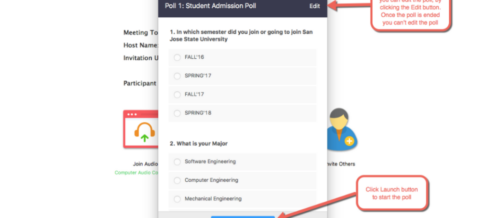
In the past, when I was physically co-present with students in the classroom, I was able to “read the room” and get a pulse of where our learning community was. By this, I mean I was able to fairly quickly track my students’ understanding of an idea or topic by their body language and facial expressions, questions they asked each other that I would overhear, or questions asked for a simple show of hands. This semester with my remote class, the small Brady-bunch squares hide these non-verbal cues and raising hands is hard, especially in my larger, 28-person classroom. I cannot quickly scan my screen and get as clear a sense of my students’ comprehension.
This semester, I have used Zoom polling to help me read the room. As the semester has progressed, I have found that different types of questions can serve different purposes.
I will often ask simple simple logistical questions, the kind that I would assess with hand raising in a physical classroom:
Do you prefer smaller or bigger breakout groups?
- Bigger
- Smaller
- Neither
- Both
I will also ask opinion-type questions about the readings, to spur discussion and figure out what students are thinking.
Do you agree with Sahlins that in many ways hunter-gatherers were more affluent than we are?
- Yes
- No
Finally, I have explored questions that often surprise, these are still opinion-type questions but I find students are often really interested to hear what their classmates are thinking:
I would be comfortable with an Alexa (or some such digital assistant outside my phone):
- not at all
- in my living room or kitchen
- in my bedroom
In terms of my friendship networks, I am most like what McCabe calls a:
- Compartmentalizer
- Tight-Knitter
- Sampler
What I like about Zoom polls is that I can quickly read the room on simple logistical things like group preference size or due dates for the next assignment. But then I quickly found that I can have students respond to other questions that have no right or wrong answers. For example, the friendship network question reviews key ideas from the reading and allows students to apply sociological and anthropological ideas to their own lives. I can learn more about how they are digesting and reacting to the reading, as a follow-up to the question on affluence for example, I asked students on each side to tell me why they answered yes or no. Or questions that cause a reaction like the Alexa question, in the context of surveillance and privacy.
Students are almost always surprised to see their classmates’ preferences and ideas, which serves the purpose of allowing all of us to read the room together! I’ve found polls also allow me to diversity the voices that participate and I can quickly create a poll in the context of Zoom (though there was a bit of a learning curve) to ask a question that may have come up during discussion in real time.
Personally, I always share poll results in class and polls allow me to also diversify the voices by saying: “ok, if you identified as a sampler, can one of you volunteer to share why your friendship network looks like this and whether it has had the same impact on your academic performance that McCabe describes in her article?” which more often than not allows me to get an array of views and prompts some students who are not natural volunteers to share. I’m sure there are other extensions, but I use Zoom polls not for right/wrong answer questions but rather, ones that stimulate and spark discussion and give me a sense of students’ thoughts and opinions.
So, the real question – back in “normal times” could I really read the room as well as I thought? I’m not exactly sure, and of-course we lose much by moving away from physical co-presence. But, this built in Zoom feature allows me to figure out what students are thinking without doing lots of counting in my head with hands raised, and is one way to ensure students and their perspectives are seen and heard – even, or especially, remotely.

Shiri Noy
Assistant Professor
Anthropology & Sociology
